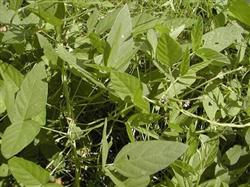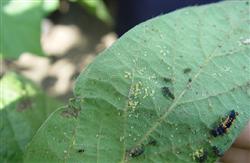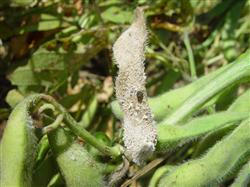How to prevent low yield from planting soybeans?

How to prevent low yield when planting soybeans? Please give guidance on the current agricultural production, planting soybeans basically no fertilizer (especially summer soybean production areas). The main reason is that most people think that soybeans can fix nitrogen, grow soybeans without fertilizer, and can also leave a certain amount of nitrogen for subsequent crops. It is precisely because of this erroneous understanding that the soybean yield in production is relatively low, generally maintained at about 150 kg/mu. In fact, the yield level of soybean varieties currently promoted is generally 225 to 275 kg/mu, and the high-yield varieties are close to 300 kg/mu. As a result of non-fertilization and extensive management, 70 to 100 kg of soybeans per mu were harvested less. Soybean can fix nitrogen, but the amount of nitrogen fixation is limited, and its effect is mainly from flowering to grain filling stage. About 40 days before flowering, the nodules are small and few, and the nitrogen fixation effect is very small. At the later stage of grain filling, the nodules are senescent, and the nitrogen fixation effect decreases rapidly. Generally speaking, the nitrogen provided by soybean nitrogen fixation accounts for only about 30% of the nitrogen required for soybean growth; under suitable conditions, it can reach about 50%. At present, soybean production areas are mostly affected by soybean cyst nematode disease, root rot and other diseases, and their nitrogen fixation is affected. In addition, the number of nodules and nitrogen-fixing capacity decreased under phosphorus deficiency. Even if nitrogen fixation provides 100% of the nitrogen required for soybean growth, soybean growth requires phosphorus, potassium and trace elements. According to the determination, for every 100 kg soybean seed produced, about 8.25 kg of pure nitrogen, 1.75 kg of available phosphorus and 3.60 kg of available potassium need to be absorbed. According to the actual soybean yield of 250 kg/mu, the amount of nitrogen, phosphorus and potassium required per mu of soybean grain is 20.63 kg, 4.38 kg and 9.00 kg respectively. In addition to the grain needs more nutrients, its stem contains nitrogen, phosphorus, potassium is much higher than other food crops. The nitrogen, phosphorus and potassium contents of soybean stalk were 1.3%, 0.3% and 0.5%, respectively. The economic coefficient of soybean is generally between 0.25 and 0.50. According to 300 kg soybean straw per mu, the nitrogen, phosphorus and potassium contents of straw are about 3.90 kg, 0.90 kg and 1.50 kg respectively. The above analysis can be seen that soybeans are crops that need more fertilizer. Even if nitrogen fixation can provide 50% of the nitrogen required by soybeans, to achieve its due yield, soil and artificial land should provide 13.90 kg of pure nitrogen, 5.28 kg of phosphorus, 10.50 kg of potassium and various trace elements per mu of soybeans, not including the consumption of nutrients such as leaves and pods. In fact, soybean's demand for nutrients is greater than this data. General soil fertility, in the absence of artificial fertilization, it is difficult to meet the needs of normal soybean growth, but also difficult to play a soybean yield level. Although soybean needs a large amount of fertilizer, soybean is a deep-rooted crop and can absorb nutrients from deeper soil. In the production, the general fertility of the plot, usually the amount of fertilizer nitrogen 2~4 kg/mu, phosphorus 5~8 kg/mu, potassium 4~9 kg/mu and appropriate trace elements, can obtain a more ideal yield. The nitrogen requirement of soybean is about 20% of the whole growth period before flowering and at the late stage of grain filling, and about 60% of the whole growth period from flowering to the middle stage of grain filling. The phosphorus uptake is 15% of the total phosphorus uptake before flowering, 60% from early flowering to pod setting, and 25% from pod setting to grain filling. The potassium requirement is more than 30% before flowering, 60% from flowering to grain filling, and less than 10% from grain filling to maturity. According to the law of soybean fertilizer demand, soybean nitrogen demand is the largest in the middle period, phosphorus and potassium demand is large in the middle and early period. Therefore, phosphorus and potassium fertilizer should be applied early as well, preferably as base fertilizer. Summer soybean planting mostly takes wheat as the preceding crop. In order to compete for time, most plots have no time to plow and sow, which brings difficulties for soybean basal fertilizer application. In this case, soybean should be combined with intertillage weeding and soil cultivation to fertilize, generally before flowering to apply ternary compound fertilizer, the amount of fertilizer according to the previous crop and soil fertility appropriate increase or decrease. Phosphorus and potassium fertilizer should be applied at one time, nitrogen fertilizer can be applied twice, 1/3 at seedling stage and 2/3 at flowering stage. After flowering, foliar fertilization was the main method of fertilizer removal due to the difficulty of operation. Foliar fertilizer can be sprayed with 1 kg of diammonium phosphate or 1 kg of urea plus 1.5 kg of calcium superphosphate (calcium superphosphate should be pre-soaked for 24 hours and then sprayed), 50~60 kg of water; or a mixture of 0.3% potassium dihydrogen phosphate and 0.2% urea, 50 kg per mu, sprayed in the evening on a sunny day from pod setting, sprayed once every 7~10 days, and continuously sprayed 2~3 times. Click for more soybean planting technology Click for more grain and oil crop planting technology
- Prev

When to control soybean heart-eating insects?
When to control soybean heart-eating insects? Please introduce that soybean heart borer is the main pest in soybean production, with a feeding rate of 5% to 10% in general years and as high as 30% to 60% in severe years. The damaged beans not only reduce the yield, but also deteriorate the quality. Master the control period and method of soybean heart borer, but.
- Next

What diseases should be controlled when planting soybeans?
What diseases should be controlled when planting soybeans? Please introduce the diseases that need to be controlled in planting soybean: 1. Soybean root rot: the disease can occur and cause damage throughout the growth period of soybean, with a yield reduction of 25-75% or more. The protein content of the damaged seeds decreased significantly, and the main symptom was the appearance of black brown at the base of the stem.
Related
- The first cup of black tea in spring, the flavor and history of tea gardens in Kenya, Africa
- The computer can not only choose potatoes, but also grow tea rice. AI will grow winter oolong tea champion.
- It is not only the inflated tea bitten by insects, but also engraved with the four seasons tea in Beipu.
- The Oriental Beauty Tea Festival in Zhuxian County takes the stage at the weekend to experience the plus-size feast of oil tea.
- & quot; Oriental Beauty Tea & Exploration of Emei in Hsinchu, the hometown of quot;
- The new variety of strawberry "Tainong 1" dessert is the first choice with mellow aroma. Crimson gorgeous
- History of Tea in Taiwan: from Wild Inner Mountain to Export Tea Garden
- Two types of Taiwan Oriental Beauty Black Tea won the British three-Star Award for Childhood Tea Xiang Zhang Jiaqi changed from pilot to champion tea maker.
- Banana species and varieties: the planting history of Taiwan Xianren banana and dwarf banana is long, is banana disease resistant?
- Coffee planting Technology: Qianjie Coffee from Seedling to harvesting

